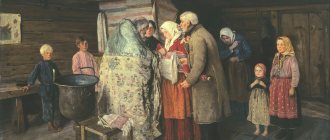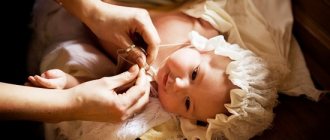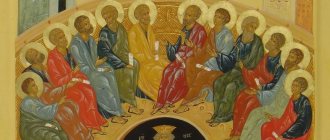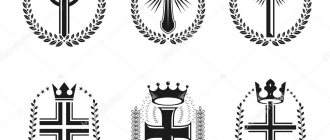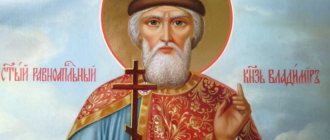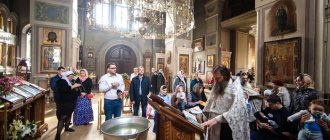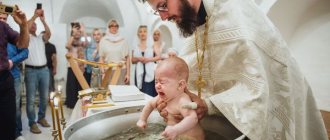4 August
Back
Baptism in the Armenian Apostolic Church
has its own characteristics and traditions. To understand them, it is worth turning to the history of religion. The Armenian Church belongs to a branch of Monophysitism. This branch of religion is a creed that recognizes the only principle in the Savior.
Supporters of the Monophysite churches agree that there is only one will in Jesus, and its only source is his divine nature. This is the main difference between the doctrine and the Orthodox, which sees both the human and divine principles in the Savior.
Armenian baptism
takes place with the performance of ritual actions similar to long-standing East Syrian traditions. All prayers and actions performed during the baptismal rite are similar in meaning and order to the actions that are determined by the Byzantine rite of Baptism. Careful preparation is necessary before the sacrament. It is necessary to consider in more detail the preparatory stages and the sequence of events during the ritual.
Preparation for the ceremony
Baptism consists of a ceremony followed by confirmation. A person of any age group can undergo the sacrament - both adults and children. More often, the ritual is performed in infancy, in one of the first months of life. The recipient of the sacrament is a man who is Armenian, has already undergone baptism, and knows the main features of the religion.
Before the sacrament, you must purchase a pectoral cross and a rope for it. It should be made from a weave of red and white thread. The rope is called “narot”, and the threads of these colors are symbols of the blood that flowed from the side of Christ and water. For the procedure, you need to take a towel and a shirt - snow-white baptismal clothes.
Armenian Epiphany: Christmas and Epiphany on the same day
The Armenian Apostolic Church (AAC), the only one among Christian churches, will celebrate on Monday, January 6, the feast of the Nativity of Christ simultaneously with Epiphany under the general name of Epiphany.
Catholicos of All Armenians Karekin II will serve a solemn Christmas liturgy at the Cathedral of Holy Etchmiadzin. The service will be attended by country leaders, government members, deputies, politicians and parishioners.
Only the Armenian Church has preserved the ancient custom of celebrating the Nativity of Christ and Epiphany on the same day. Other churches celebrate Christmas on December 25 or January 7, and Epiphany on January 6 or 19.
The week leading up to Christmas - from December 30 to the evening of January 5 - is considered fast. These days, products of exclusively plant origin are used.
According to the old calendar, Armenians celebrated the New Year on the 1st of the month of Navasard, that is, on August 11, when there was no fasting. With the adoption of the new chronology, the New Year began to be celebrated on December 31 - the day coinciding with Lent preceding Christmas.
They end the fast on January 5, on the evening of Christmas Eve, when the Christmas liturgy is celebrated in churches. People greet each other with the words: “Christ was born and appeared! Blessed is the appearance of Christ!” (“єրիստոս ծնավ և հայտնեցավ Մեզ և Ձեզ մեծ ավետիս”)․
The holiday of Christmas and Epiphany is the day of the coming into the world, that is, the appearance of Jesus Christ. It begins on the evening of January 5, as the church day follows the evening service.
First, they serve the holy liturgy of Chragaluytsa, which takes place twice a year - on the holidays of Christmas and Resurrection. “Chragaluyts” means “lighting of lamps” (lamps), which symbolizes the light of the Bethlehem star, which showed the Magi the way to the baby Jesus. Also during the liturgy, candles are lit, symbolizing divine light and the blessing of the church. Therefore, people take the lamps and candles lit in the church to their homes.
On January 6th, after the Christmas liturgy, the Blessing of Water takes place, which symbolizes the baptism of Christ in the Jordan River. The water is blessed with the Bible, the cross and peace, after which it is distributed to those present. The next day, the liturgy of remembrance of the dead is served in the Armenian church, and a memorial service is performed to calm the souls of the deceased.
During Christmas celebrations, houses are also blessed. However, people invite the clergyman to their home or place of work, wanting to receive God’s blessing, even after Christmas and the Resurrection.
On the seventh of January, as on all days immediately following the main holidays, the remembrance of the dead is celebrated - Merelots. After the Divine Liturgy, in all churches they pray for the repose of the soul, after which people visit the graves.
Christmas rituals continue until January 13, until the feast of the naming of the Lord.
Holy Sacrament: Baptism
What is Baptism? Baptism is the Birth from Above, since the one baptized (by immersing the body three times in water with the invocation of God the Father and the Son and the Holy Spirit), being cleansed from original sin (if an adult, then the sins committed are forgiven) dies to a carnal, sinful life and is reborn by the Holy Spirit into life spiritual, holy.
“Unless one is born of water and the Spirit, he cannot enter the kingdom of God.”
/John
3:5/. Where does Baptism originate? Baptism began with John the Baptist first on the Jordan
“baptized with the baptism of repentance, telling people to believe in him who should come after him, that is, in Christ Jesus”
/Acts
19:4/. Then Jesus Christ, by His example, sanctified Baptism, receiving it from John.
Finally, after His resurrection, He gave the Apostles a solemn command:
“Go and make disciples of all nations, baptizing them in the name of the Father and the Son and the Holy Spirit.”
/Matt. 28:19/. What is Original Sin?
Original sin is the first sin committed on earth by our ancestors Adam and Eve, and therefore this sin is also commonly called Adam’s sin.
Adam's sin was that he lost righteousness and in sin and passion gave birth to his son, and he gave birth to his son:
“Behold, I was conceived in iniquity, and my mother bore me in sin.”
/Psalm.
50:5/.
“...just as sin entered the world through one man, and death through sin, so death spread to all men, because all sinned in him...”
/Rome. 5:12/. What is required of those who wish to receive Baptism?
Faith in the Holy Trinity is required of those who wish to receive Baptism, and therefore
“Whoever believes and is baptized will be saved, but whoever does not believe will be condemned.”
/Mk.
Van: childbirth, christening and child care - Armenian rituals and customs of the 2nd half of the 19th - early 20th centuries.
Ethnographer Yervand Lalayan, traveling through Western Armenia in 1913, left a note in his notebook: “The position of a woman in Van who is unable to bear children is extremely unenviable. Having no idea about the cause of infertility in each specific case, those around him place all the blame for this on the poor woman, she becomes an outcast. Therefore, wives are ready to do anything to give birth to a child. First of all, they go on pilgrimage to various shrines, chapels, where they sacrifice a rooster or a ram, light candles, pray fervently, and deliberately take away some little thing from such places. If prayers and sacrifices produce the desired result, the borrowed item is returned in double size. A child born under the shadow of a saint to whom prayers were addressed is given the name of this saint or he is called Kristotur (i.e. Christopher), Tiratur, Astvatsatur (i.e. Bogdan). Baptism takes place in the appropriate monastery or chapel.”
Vans, as a rule, try to fulfill all the whims of a woman in labor related to food and drink. On this occasion, the following parable is told: one day a woman in labor and her husband were returning home from their parents on horseback and noticed a pomegranate seed in the dirt of the road. Despite her husband's protests, she got off her horse and, picking up the grain, ate it. Enraged by his wife's greed, the husband rips open her stomach with a dagger and sees that this grain is in the mouth of the uterine child.
To determine the sex of an unborn baby, pay attention to the following:
A pregnant woman puts a louse found on herself in her palm and, covering it with earth, watches: if the louse comes out through the top of the earthen pile, then the unborn child will be a boy, but if the louse appears from the side, then the child will be a girl.
When baking bread, throw a piece of dough into the tonir and observe: if the dough rises without cracking, there will be a girl.
If a pregnant woman's navel is facing upward, then the child will be male, and if it is downward, the child will be female.
If the ends of the nipples are black, then a boy will be born, and if the ends are white, then a girl will be born.
If a woman's hips are wide, she will have a boy; if her hips are narrow, she will be a girl.
If a pregnant woman's face is happy, it will be a boy, and if it is sad, it will be a girl.
If the belly is round, a boy will be born; if the belly is oblong, a girl will be born.
If in the womb the child begins to move at an earlier stage, then a boy will be born, but if later, a girl will be born.
If the fetus is visible on the right side of the abdomen, it will be a boy, and on the left, it will be a girl.
If a pregnant woman finds a pin, it will be a boy, if a needle finds a girl.
If a pregnant woman spreads her legs when sitting down, it will be a girl.
If a pregnant woman has easy movements, a quick gait, and an upright posture, then she will give birth to a boy, otherwise - a girl.
A drop of milk is squeezed out of a pregnant woman's breast into a glass of water. If the drop goes to the bottom, there will be a boy, if it remains on the surface of the water, it will be a girl.
If you suddenly shout to a pregnant woman: “Why are your hands dirty?” and she looks at the back of her hands, then a boy will be born, but if a woman looks at her palm, she will be a girl.
In Van, soothsayers predict the gender of the unborn child as follows: add the number of letters of the parents' names and the zodiac sign of the moment of conception. If the sum is an even number, a girl will be born; if it is odd, a boy will be born.
It is a common belief that if a husband is more energetic, shorter and plumper than his wife, they will predominantly have boys, otherwise they will have girls.
In an effort to impart certain abilities and character traits to their future children, they resort to various tricks:
They steal an egg, boil it and eat it secretly on the street, while putting a finger to their cheek and saying: “I want there to be dimples in these places.”
They go to Lake Van and drink the water so that the unborn child’s eyes will be blue and his hair will be blond.
They put earth from holy graves in their mouths so that birthmarks appear on the child’s chest, under the nipples.
Believing that the unborn child takes on his character traits from those people who appear in front of his mother when he moves in the womb, the mother tries to be surrounded by good people.
A pregnant woman is treated with great respect, and this attitude is based on both the likelihood of great future happiness of motherhood and the possibility of a disastrous outcome in the event of an unsuccessful birth. With the first contractions, the grandmother is invited to the house where the woman in labor is. If the birth is the first, her mother may well be with the mother during the first stages.
Having arrived at the birth, the grandmother first of all draws an iron rod (skewer) crosswise along each of the four walls of the room, thereby driving out evil spirits and brownies, who are believed to be encroaching on the well-being of the woman in labor. And then, placing this iron rod in the hands of the woman giving birth, the grandmother begins to pronounce prayers and spells appropriate to the occasion. Then she makes the woman in labor squat, facing east. Two women squat in front of the woman in labor and hold her knees and hands. Squatting behind the woman in labor, the grandmother squeezes her buttocks and with extreme caution accepts the child striving to come into this world. While performing all these manipulations, the grandmother does not forget to say prayers, call on saints, angels, the moon, stars, etc. for help.
If childbirth is difficult, resort to the following ritual actions:
A person who has crossed the Euphrates is asked to blow three times into the mouth of a woman in labor or let her drink water from the hem of her dress.
They bring a mare to the door behind which the woman in labor is located and say: “Give birth quickly, otherwise the horse will give birth!”
In case of fainting from strong efforts, a rosary made from Jerusalem olive seeds is placed in the hands of the woman in labor.
If none of the above remedies brings relief, they shoot with a gun, hit copper dishes and a cauldron, pull the nose of the woman in labor, and slap her in the face. Such actions, designed to intimidate and drive out evil spirits, are dictated by the belief that these “alk” spirits have entered the body of the woman in labor and intend to take away her liver. Pursuing the same goal of getting rid of evil spirits, a saber, a dagger, an iron rod, a Gospel, a missal, various talismans are placed near the woman in labor - everything that is believed to disgust evil spirits and forces them to flee in horror. They are pursued by guardian angels with a fiery saber in their hand, and they bring the woman in labor to her senses.
Before cutting the umbilical cord of a newborn, the grandmother demands a gift from the parents. The umbilical cord of the firstborn is cut at the hem of a childless woman in order to thus save her from infertility. A girl’s umbilical cord is taken to the storeroom so that in the future she will become a good housewife; a boy’s umbilical cord is taken to church so that he will later become a good choirboy or deacon. For a good complexion and blush, sometimes the blood of the baby's umbilical cord is smeared on his cheeks.
After cutting the umbilical cord, the woman in labor is laid on ashes or earth, changing them every two hours. The woman in labor remains in this position for one or two days. At the same time, in order to avoid any troubles, her stomach is tied with a scarf or shawl, and her head is wrapped in a scarf so that she does not catch a cold. And so that evil spirits do not take away the liver of the woman in labor, she is not allowed to sleep for some time after giving birth.
The grandmother begins to wash the newborn. First of all, water is poured into the trough, into which two handfuls of salt are thrown. 2 - 3 eggs are broken there, and everything is actively stirred until foam forms. The grandmother bathes the child in the resulting solution, then sprinkles salt on his head, in the groin area, under the arms, swaddles him tightly, and then places the newborn on the mother’s bed. “Tell me, who is easier - me or you?” - asks the grandmother. “I am,” the baby’s mother replies. “May everything pass easily!” - says the grandmother. After repeating the above short dialogue three times, the grandmother places the child to the right of the mother.
Meanwhile, the children of the house in which the child was born run away with the good news, inform relatives about the successful resolution of the burden, for which they receive small gifts. Notified relatives and acquaintances visit the mother in labor and bring her lemons, pomegranates, apples, flowers, etc. In the house where the joyful event occurred, high spirits reign, especially if a boy was born. Loud grandma chants can be heard, glorifying the accomplished happy birth with wishes of all the best to the parents of the newborn, etc. Having finished her song, the grandmother places bread on the belly of the woman in labor, and then, breaking it into two parts, throws it to the dog, thereby transferring all illnesses and misfortunes from the woman in labor to the dog. The guests present the grandmother with money, which gives her great pleasure. If a girl is born, almost no praise is heard. Instead, consolations addressed to the mother of the newborn are heard that with God's help, next time she will certainly give birth to a son.
In naming a child, the opinion of older family members plays a decisive role, although the wishes of the baby’s parents are also taken into account. There are no doubts or disputes if the newborn “brings the name with him,” i.e. the child's birthday coincides with the calendar day of some saint or if tribute is paid to the memory of a deceased family member, who, as they say here, “gives the child from his sun.”
BAPTISM
The child is baptized 3 to 8 days after birth, mainly on Sundays or holidays. Early in the morning on the day of christening, the mother of the baby washes the lower half of her body. The grandmother bathes the child and then visits the godfather with an invitation to come to church. She takes with her a small sugar loaf and a pair of socks as a gift. In these parts, the honorary role of godfather is inherited. The godson's mother treats the godson with great respect, bordering on servility, which prevents her from having normal communication with him in the same way as in the case of mother-in-law, father-in-law and brothers-in-law. On certain holidays, the child's mother certainly sends gifts to the godfather and receives gifts in return.
However, let us return directly to the rite of christening. On this day, the grandmother, accompanied by two elderly women, carries the baby to church. She takes with her two loaves of bread and a piece of cheese for the sexton, as well as 3 to 5 “gurus” (coins) for the priest. In the church, the grandmother swaddles the child in the baby underwear brought by the godfather and hands the child to him in such a way that his head rests on the godfather’s right hand. At the end of the sacrament of baptism, a priest in full vestments and singing spiritual chants comes to the house where the young mother is waiting for her baby. The priest is followed by the godfather with a child and candles in his hands. When they appear, the mother gets up and then sits down on the bed again. The godfather hands the child over to the mother. Having bowed to him three times, the young woman places the baby on the right side of her bed.
After the baptism there is usually a dinner party. As usual, men sit at the table first.
REMOVAL OF THE WORLD
Three days after baptism, the ritual of removing the world is performed. First, the grandmother washes the anointed parts of the body in a clean trough, and then bathes the entire baby in the bath. Having finished this, she raises the child three times, holding his head and saying different wishes. Used water is poured into a clean corner of the house, and in cases of desecration of the dishes, it is cleaned with earth from this corner. Sometimes such water is poured somewhere under a spring or in a remote, hard-to-reach place.
BABY CARE
The first night the newborn is left without breastfeeding. Before the boy is put to the chest for the first time, the tip of a knife with granulated sugar is passed over his lips, saying: “Let your word be sharp and your tongue sweet-sounding!” In order for a boy to grow up literate, a book is placed on the newborn’s mouth, and in order for him to be simply happy, a piece of bread is placed. They begin to feed the baby with the right breast, first squeezing out a few drops of milk.
Mothers who do not have enough milk take part in the following ritual. Taking with them bread, cheese, boiled eggs, incense and candles, the women go to the shrine called Katnaghbyur (Milk Spring). Having placed lighted candles on top of the spring, nursing mothers smoke incense in front of it and wash their breasts with spring water, drink this water and breastfeed a child, not their own, but someone else's - the baby of a woman nearby. Then everyone has a modest feast together, eating what they brought with them. The rest of the food is placed above the spring and they return home.
If, on the contrary, there is too much milk, the expressed excess is poured either into a tonir, or into a spring, or onto a wall facing east.
Breastfeeding is usually done for 1–3 years or until the next pregnancy. If there is not enough milk, children are fed with cow's or sheep's milk, while in the first three months more water is added to the milk, and later the same amount of sugar is added. An ox horn is used as a horn, with a cow or goat teat attached to the end. For this purpose, a straw can also be used, the end of which, framed with cotton, is placed in the baby’s mouth. The opposite end is placed in a bottle or glass filled with milk.
Local residents use women's milk as a healing potion. It is instilled into sore eyes or ears if, say, there is tinnitus. Mixed with butter and flour, it is applied like a plaster to wounds that often appear on peasant hands.
For the first forty days of life, newborns are bathed daily, immersing an iron rod, nail or knife in the bath in order to protect the child from exposure to evil forces. Then - three times a week, considering it a sin to work on the eve of Wednesday, Friday and Sunday.
While swaddling, hot sand is sprinkled under the baby's buttocks so that it warms and at the same time absorbs urine. It was probably this rule that gave rise to the saying: “A boy in diapers with soil is clean and has no unpleasant odor.” They usually swaddle 2-3 times a day.
They begin to put the baby in the cradle only after the world has been washed off. Various shells and bones are hung on a string from the crossbar above the cradle to amuse the baby, as well as blue beads to protect him from the evil eye. Before putting a shirt on a child for the first time, the baby is first placed on top of this shirt and, rocking from side to side, they say: “The bag is full, full, the child is full, full!”
It is clear that these words expressed the desire to soon see the baby plump and well-fed.
The child’s nails were not cut out of superstitious fears of “crushing” him, as a result of which he, who had become vulnerable to evil spirits, would begin to lose weight, get sick, in a word, waste away.
During the period of teething, the child is given an onion or something else edible and hard, and during bathing, the baby’s head is sprinkled with boiled grains, which are later fed to the chickens.
When an older child begins to change teeth, the fallen milk teeth are placed under the door. They open and close it, saying: “Here, take yourself a wolf’s tooth, give me a lamb’s tooth!”, which means a request for beautiful permanent teeth.
It is believed that a child may experience headaches if his hair is cut in the first year of his life. Again, so that the child does not have a headache, his first cut hair is not thrown to the ground, but is placed in a crack in the wall.
To ensure that children sleep peacefully for a long time, giving adults the opportunity to go about their business, the following superstitious actions are provided:
The diapers soiled by the baby are dried and then placed under the pillow in the cradle.
While bathing a child, a sleepy person pours water on him.
The mother washes her feet with the water in which the child was bathed.
This water is not poured out until the child falls asleep.
The child, placed on a sieve, is brought out to meet the rural shepherd returning in the evening with his flock, turning to him with the question: “Shepherd, you who came down from the mountains, have you brought a dream for my child?”
If the child still does not take his first steps, he is placed on a sieve and visited in seven houses. Knocking on the door, their inhabitants are told: “The legless man has come to ask for legs!” People present those who come with bread, eggs, raisins, etc. The food they bring home is fed to the child.
To protect against the evil eye, blue beads are sewn onto children's hats and onto the sleeves of their clothes. The disease, believed to be caused by the evil eye, is counteracted by a ritual in which a plate with cotton wool folded crosswise is placed in a cradle over a sick child. Salt is sprinkled between the vertical and horizontal of the cross and the names of those people who supposedly jinxed the child are written on it with a finger. Then they set fire to the cotton wool simultaneously from all four ends of the cross and observe. The one with the evil eye is considered to be the one near whose name the last light of the cotton cross goes out. Having thus determined the source of evil, under the veil of night, secretly they approach this person’s house and pinch off some wood from the gate. They bring it home and burn it under the cradle of an ill child in order to completely weaken the evil eye.
If a child does not begin to speak for a long time, he is taken to church, usually to the Church of the Holy Banner, and church keys are passed over his lips three times, or the little finger of some first-born boy is thrust into his mouth.
advokat-martov.ru
And so that those receiving baptism would not be deprived of the life-giving gifts of the Holy Spirit, the apostles replaced the sacrament of laying on of hands with the sacrament of anointing with oil - Confirmation, and also gave the order that the anointing be performed by priests (priests). Anointing with oil best symbolizes the effect of the grace of the Holy Spirit on the soul, for since ancient times oil has been a symbol of healing.
This follows from the Epistle of the Apostle Paul to the Corinthians.
The Christians of Corinth were infants in the faith, knowing only the rudiments of Christian teaching (1 Cor. 3:1). However, only with the human incarnation of Jesus - the coming of the Anointed One - was it fulfilled with perfect meaning.
In a word: Confirmation marks the descent of the Holy Spirit on the baptized.
During the sacrament of Confirmation, holy chrism (Armenian muron) is used. Miro is a Greek word meaning fragrant oil.
Info The sacrament of baptism in the Armenian Apostolic Church (with a description of the sacrament) Preface The need to write this brochure is due to the fact that many of those who decide to be baptized do not fully understand the importance of this step, in its meaning and significance. Baptism is accepted not because it is “such a tradition” or “so as not to get sick,” and not in order to “have success in life” or “just to be baptized,” but in order to have Eternal life in God. Having been baptized, a person takes the path of salvation from sin.
A person can travel this path only with God’s help, “for without Me you can do nothing.”
[John 15:5]. “I am the way and the truth and the life.”
Our environment
ARMENIAN TRADITIONS “online” - One of the main things in the family traditional rituals of Armenians is the customs and ceremonies associated with childbirth, the birth of a child and after the birth of a child (karasunk).
Armenian families paid great attention to the reproductive abilities of the young couple.
Unfortunately, in the old days, very often women had stillborn children, or died in the first years of life. It was because of this that magical and therapeutic procedures began to appear, which over time became traditions.
I depicted several of them in this work. The work is made in the form of a pomegranate tree (kenats tsar), the roots of which are a man and a woman, holding a seed in their hands.
The pomegranate fruit is a tradition, and the tree ends with a gemma, which means that the child’s whole life is still ahead. The first grenade depicts the moment when a pregnant woman jumps over a pregnant animal. They could be any domestic animal: cat, dog, cow, sheep, etc.
It was believed that in this case the disease, which was called tkhpotutyun (venereal diseases), would be transferred to the animal, and the child would be born healthy. The disease was named after the monster Thpi.
In medieval manuscripts, Thpi was depicted as a Minotaur, depicted to the left of a pomegranate.
Above the pomegranate is a snake with a frog in its mouth.
This is another way to treat a patient.
A frog was taken from the snake's mouth and made into a talisman that was worn by a sick woman. The Armenians believed that the disease could be sent to a pregnant woman by evil women who, with the help of tkhpaulunk (blue stones that fall during hail), sent damage.
In every village there was a woman who had the skill of giving birth.

